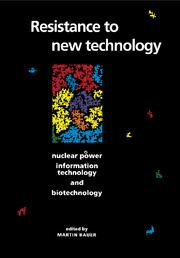Book contents
- Frontmatter
- Contents
- Contributors
- Preface
- 1 Resistance to new technology and its effects on nuclear power, information technology and biotechnology
- PART I Conceptual issues
- PART II Case studies
- PART III International comparisons
- 11 The politics of resistance to new technology: semiconductor diffusion in France and Japan until 1965
- 12 User resistance to new interactive media: participants, processes and paradigms
- 13 The impact of anti-nuclear power movements in international comparison
- 14 In the engine of industry: regulators of biotechnology, 1970–86
- 15 Product, process, or programme: three cultures and the regulation of biotechnology
- PART IV Comparisons of different technologies
- PART V Afterword
- Index
13 - The impact of anti-nuclear power movements in international comparison
Published online by Cambridge University Press: 06 July 2010
- Frontmatter
- Contents
- Contributors
- Preface
- 1 Resistance to new technology and its effects on nuclear power, information technology and biotechnology
- PART I Conceptual issues
- PART II Case studies
- PART III International comparisons
- 11 The politics of resistance to new technology: semiconductor diffusion in France and Japan until 1965
- 12 User resistance to new interactive media: participants, processes and paradigms
- 13 The impact of anti-nuclear power movements in international comparison
- 14 In the engine of industry: regulators of biotechnology, 1970–86
- 15 Product, process, or programme: three cultures and the regulation of biotechnology
- PART IV Comparisons of different technologies
- PART V Afterword
- Index
Summary
Introduction
Nuclear energy's initial associations with weapons, war and death were balanced and eventually overcome by politicians and scientists promising ‘Atoms for Peace’. That was the slogan to promote the civilian use of nuclear power in 1953. Now associated with a positive and bright future, nuclear power promised virtually infinite energy; according to Lewis Strauss, president of the US Atomic Energy Commission in 1954, nuclear power would be ‘too cheap to meter’ (Ford 1982, p. 50). Today, as we know, this bright vision has dimmed. Nuclear power is now associated with rising costs, problems of waste disposal, accidents, and fierce citizen opposition. Probably for the first time, a major online technology has been successfully challenged through a long and intense struggle including millions of citizens. The impacts of these struggles have been multi-faceted. The immediate substantial policy outcomes vary from country to country. In some places, despite promoters' efforts, nuclear power programmes were never realized. In others, programmes were realized only in part. In still others, nuclear power programmes were implemented in the face of significant opposition. Overall, however, the tide in the last two decades has turned and nuclear power has been discredited. Even in such countries as France and Belgium where nuclear power produces the lion's share of electricity supply, it is perceived as a necessary evil to be tolerated, at least for a few decades, because of huge capital investments.
- Type
- Chapter
- Information
- Resistance to New TechnologyNuclear Power, Information Technology and Biotechnology, pp. 277 - 292Publisher: Cambridge University PressPrint publication year: 1995
- 3
- Cited by

